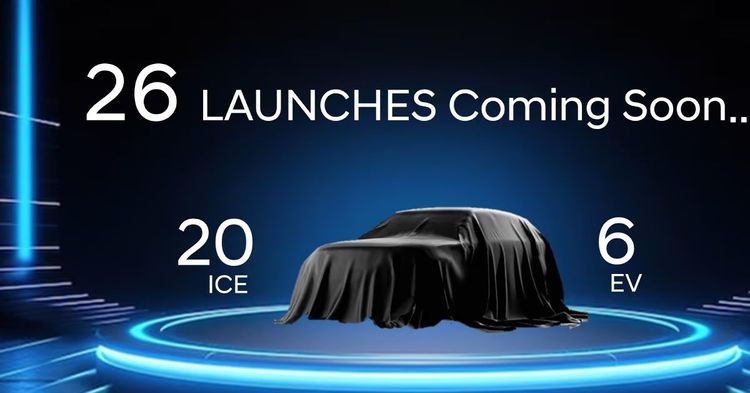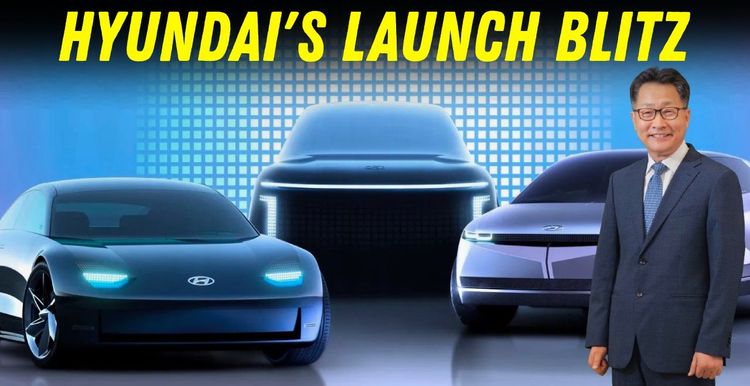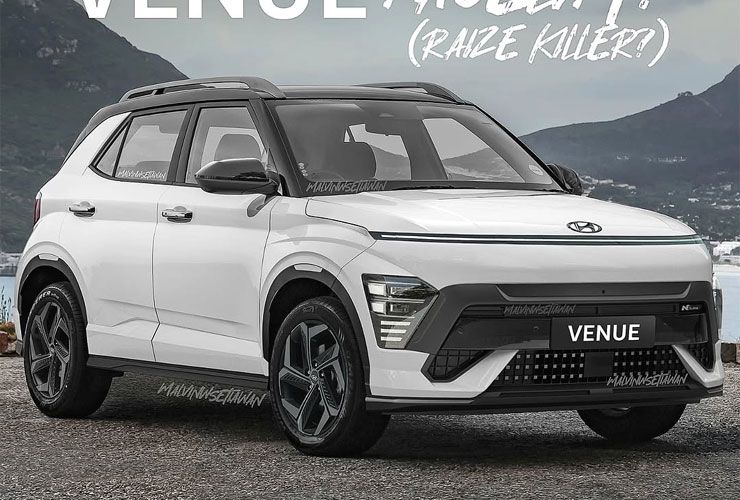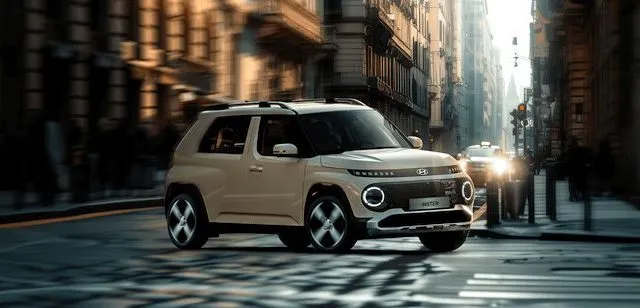Hyundai Coming After Tata And Mahindra With 26-Car Onslaught


Hyundai India has just pulled the wraps off its most ambitious product roadmap yet. It plans to launch 26 new models by FY2030, including six EVs and several hybrids. This aggressive strategy is not just about expanding its lineup.

It is a direct response to the rapid rise of Mahindra and Tata Motors, both of whom have gained significant ground in the past year through focused SUV portfolios and a strong push in electric vehicles.
For Hyundai, this is no longer about defending its second spot. It is about reclaiming market leadership in the most competitive segments of India’s automobile industry. The company is now targeting specific weaknesses in Mahindra and Tata’s offerings, with carefully developed next-generation products.

Until recently, Hyundai was India’s consistent number two carmaker behind Maruti Suzuki. But a sharp swing in consumer preference towards SUVs, especially rugged and feature-rich ones, has shifted that hierarchy. Mahindra surged ahead in monthly sales by doubling down on body-on-frame SUVs like the Scorpio N, Thar, and XUV700.
Tata, on the other hand, leveraged its growing EV portfolio, safety-first reputation, and competitive pricing to close the gap further. Result: In April 2025, Hyundai dropped to 4th position on sales charts behind Maruti Suzuki, Mahindra and Tata Motors with its market share at lowest point in the past 12 years.
Hyundai’s challenge was not product quality. Its issue was a spread-out portfolio that diluted its focus. While the Creta remained a strong seller, other models such as the Venue, Alcazar, and Tucson lost ground. Hyundai’s sedans and hatchbacks also struggled against the rivals and suffered due to the growing shift towards SUV.

Hyundai’s new roadmap includes 20 internal combustion engine models and six electric vehicles. These models are being designed not as broad updates, but as direct competitors to specific Tata and Mahindra products. Each one will aim to offer a clear advantage in refinement, fuel economy, technology, or powertrain options.

The Creta facelift is already in the market. Next up is an all-new version of the Creta - a strong hybrid version that will go directly up against the Grand Vitara and Toyota Hyryder. Hyundai will perhaps offer more premium experience, greater power with good fuel economy and a more refined drive compared to the competition’s efficient engines but less powerful engines.
The Alcazar will also receive a significant update with better packaging for the third row and the possibility of hybrid power. It might be built-from-scratch model than a stretched Creta which will position it more strongly against the Safari and XUV700.
The hybrid powertrain is expected to deliver higher fuel efficiency, lower noise and vibration, and improved city drivability. These are areas where both Tata and Mahindra still have to catch up, especially in petrol variants.

Hyundai will bring a next-generation Venue by 2025 with a more squared-off design, improved interior space, and a possible hybrid option. It will be followed by an all-new compact SUV that will sit between the Venue and Creta. This SUV is being designed specifically to take on the Nexon, XUV 3XO, and even the Punch EV.
This new SUV is likely to offer turbo-petrol and hybrid options, connected features, and better space management. Hyundai is focusing on refinement and mileage as its differentiators in this space.
Where Mahindra and Tata lead with rugged design and competitive pricing, Hyundai aims to respond with smoother engines, a quieter cabin, and more advanced infotainment and driver assistance features.

Hyundai is working on a mass-market EV that will sit below the Creta EV and is expected to arrive before 2027. This model will use a modified internal combustion platform to keep costs competitive. It is aimed directly at Tata’s EV portfolio, particularly the Punch EV and Nexon EV.
In the premium space, the Ioniq 5 facelift will arrive with new features and enhanced range, taking on Tata’s Avinya and Mahindra’s BE.05 and XUV.e8. Hyundai is confident that its global battery technology and more refined EV platforms will allow it to offer better energy efficiency, faster charging, and more stable long-term performance.
The next-generation Tucson is expected to arrive around 2026 with hybrid and all-wheel drive options. A premium SUV just below Tuscon will go up against Mahindra’s Scorpio N and XUV700 AWD, both of which offer strong off-road and towing capabilities.
Hyundai will approach this segment differently. Rather than focusing on off-road toughness, it will offer superior ride comfort, advanced cabin features, and enhanced ADAS technology. A new premium SUV, possibly based on a stretched Tucson platform, is also expected and could offer third-row seating with an urban luxury positioning.
Beyond hybrids and conversion EVs, Hyundai is developing dedicated EVs for India. One of these is expected to be a compact born-EV SUV positioned above the Creta EV. It will compete with Mahindra’s BE.05 and Tata’s Avinya. This vehicle will likely use the E-GMP platform in a cost-down version, offering high efficiency, a flat floor cabin, and vehicle-to-load charging capabilities.
Hyundai is also working on localising its EV supply chain in India to bring prices down by 2028. This is critical in competing with Tata’s heavily localised and aggressively priced EVs.
Hyundai’s strength has always been in areas like fit and finish, infotainment systems, and urban refinement. The new plan will deepen this focus while adding:
• Expanded ADAS availability across most models
• Voice commands, connected car features, and over-the-air updates
• Better cabin space management, especially in compact and midsize SUVs
• A wider service and parts network to support hybrid and EV products
For buyers, Hyundai’s new product strategy will create more choices across every price band. Whether someone is looking for a city-friendly hybrid SUV, a practical long-range EV, or a tech-loaded premium family car, Hyundai wants to be front and centre.
Unlike Tata, which is EV-led, and Mahindra, which is SUV-specialist, Hyundai is attempting to offer a complete portfolio. But this time, with sharper segmentation, more meaningful updates, and powertrains designed to solve real-world buyer concerns.
The fight for the second spot in India’s auto market is intensifying. Hyundai is no longer looking to defend its turf. It is preparing to retake it, product by product.